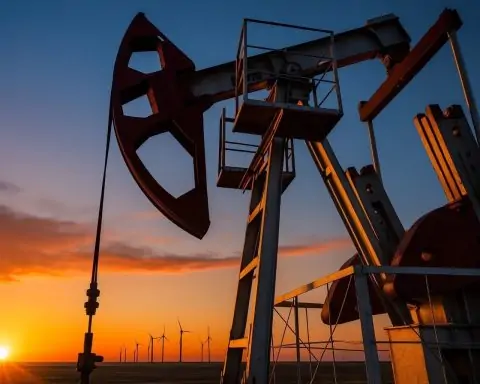WTI crude is hovering just above $58 a barrel and U.S. gasoline averages about $3.07 a gallon as Treasury Secretary Scott Bessent suggests that “if something happens” in Venezuela or in the Russia‑Ukraine war, Americans could see even cheaper energy. Critics warn the opposite is just as likely.
Published: November 23, 2025
Bessent’s cryptic Venezuela comment lands in a fragile oil market
Treasury Secretary Scott Bessent, a longtime hedge fund manager who took over at Treasury in January, has quickly become one of the most visible faces of President Donald Trump’s economic agenda.
On Thursday night, during an interview on Fox News’ The Ingraham Angle, Bessent argued that the U.S. is enjoying a “peace dividend” from Trump’s foreign policy and pointed to falling energy costs as proof. He then delivered the line that has dominated the weekend’s energy chatter:
If something happens with Russia‑Ukraine, if something happens down in Venezuela, oil prices could go down even more.
The remark, first highlighted in detail by Newsweek, came as Bessent stressed that oil and gasoline are cheaper under Trump and that lower energy costs are “key” to making life affordable, especially for younger Americans. [1]
What he didn’t do is spell out what exactly he expects to “happen” in either conflict — a diplomatic breakthrough, tougher sanctions, or outright military action. That ambiguity matters, because different scenarios could move prices in very different directions.
Where oil and gas prices actually stand today
Crude oil: one‑month lows after peace‑plan headlines
Global oil prices have been drifting lower for weeks, pressured by ample supply and a stronger dollar even as geopolitics stay tense. On Friday, benchmark crude futures settled at their lowest levels in about a month:
- Brent crude closed around $62.56 per barrel, down roughly 1.3% on the day.
- U.S. West Texas Intermediate (WTI) ended near $58.06 per barrel, down 1.6%. [2]
Both benchmarks are down about 3% over the week and roughly 16–18% compared with a year ago, according to data from Trading Economics and CME futures. [3]
A major driver of Friday’s move was Washington’s push for a 28‑point peace plan to end Russia’s war in Ukraine. Reuters reported that traders see a successful deal as potentially boosting global oil supply by easing sanctions pressure on Russian exports, just as new U.S. sanctions on Rosneft and Lukoil begin to bite. [4]
Gasoline: cheaper than last year, barely moving into Thanksgiving week
At the pump, the picture is calmer:
- Today’s AAA national average for regular gasoline is $3.07 per gallon, essentially flat versus both a week and a month ago and just a hair above last year’s level of $3.06. [5]
- Wholesale gasoline prices are also subdued: benchmark U.S. gasoline futures sit around $1.88 per gallon, down nearly 9% over the past 12 months. [6]
Regional AAA reports show similar stability. In Texas, for example, the statewide average is about $2.70, while West Coast drivers are still paying closer to $3.80–$4.30, but with little movement week‑to‑week. [7]
Local pieces from outlets like The Gaston Gazette and others note that the national price is “essentially unchanged” from last week heading into Thanksgiving, even as travel is expected to set fresh records. [8]
In other words: Bessent is right that fuel is much cheaper than during the 2022 price spike, and fairly steady right now. Where analysts push back is on the idea that a shock in Venezuela or Ukraine automatically guarantees even lower prices.
Venezuela: terror designation, military buildup and oil in the crosshairs
Bessent’s Venezuela comment comes against a backdrop of rapidly escalating U.S. pressure on President Nicolás Maduro’s government — pressure that is explicitly tied to both narcotrafficking and terrorism.
Cartel de los Soles labeled a terrorist organization
Last week, the U.S. State Department confirmed that Cartel de los Soles, a state‑embedded drug network Washington claims is headed by Maduro and senior military officers, has been formally designated a Foreign Terrorist Organization (FTO) effective November 24. [9]
U.S. officials say the network works closely with Venezuelan gang Tren de Aragua, itself now labeled a terrorist group, and with Mexico’s Sinaloa cartel to move cocaine into the U.S. and Europe. [10]
This designation is not just symbolic. It:
- Expands sanctions tools against individuals and entities tied to the Venezuelan state.
- Opens more legal pathways for the Pentagon to target the group as part of counter‑terror operations, not just counternarcotics missions. [11]
Defense Secretary Pete Hegseth has publicly said the terrorist label brings “a whole bunch of new options” for how the U.S. can act against Maduro‑linked networks — language that has fueled speculation about strikes on Venezuelan soil. [12]
U.S. warships offshore, FAA warns pilots
That speculation is not happening in a vacuum. Over recent months, Washington has:
- Deployed a powerful naval task force centered on the USS Gerald R. Ford and other warships to Caribbean waters near Venezuela as part of “Operation Southern Spear”. [13]
- Carried out more than 20 lethal strikes on alleged drug‑smuggling boats off Venezuela’s coast, operations that human‑rights groups and some U.S. allies say amount to extrajudicial killings. [14]
- Triggered an FAA advisory warning pilots about a “worsening security situation” and heightened military activity in Venezuelan airspace. [15]
An exclusive report published today says the U.S. is preparing a new phase of operations linked to the upcoming FTO designation, with Trump publicly noting that the terror label gives him authority to strike “assets and infrastructure” linked to Maduro, even as quiet contacts continue between Washington and Caracas. [16]
Venezuela’s oil sector: sanctions, Russian ties, and what’s at stake
Despite years of mismanagement and sweeping U.S. sanctions, Venezuela still sits on the world’s largest proven crude reserves and remains a meaningful exporter of heavy oil. PDVSA, the state oil company, has leaned on partners like Russia to keep some production flowing.
Just this week, Venezuela’s National Assembly approved a 15‑year extension of joint ventures between PDVSA and a Russian state‑linked company to operate the Boquerón and Perijá oilfields, targeting about 16,600 barrels per day of production and some $616 million in investment. [17]
Trump has further tried to isolate Caracas by signing Executive Order 14245, which slaps a 25% tariff on all goods imported into the U.S. from any country that buys Venezuelan oil — an unprecedented attempt to make Venezuelan barrels toxic in global trade. [18]
All of this means any “something” that happens in Venezuela — from limited U.S. airstrikes to a broader conflict, or alternatively a sanctions‑lifting deal — could have direct implications for:
- Venezuelan export volumes, especially of heavy crude used by U.S. Gulf Coast and Asian refiners.
- Shipping risk for tankers moving through the Caribbean and Atlantic.
- Russia’s footprint in Western Hemisphere energy via its joint ventures.
Crucially, though, not every scenario is price‑bearish.
When rumors of imminent U.S. airstrikes on Venezuela circulated on October 31, Brent and WTI spiked intraday before slipping back after Trump publicly denied attack plans. Traders told Reuters that a real strike would likely send prices “spiking” when markets reopened. [19]
Russia‑Ukraine peace plan: Bessent’s other lever on oil
Venezuela is only half of Bessent’s equation. His comment also linked potential further price declines to “something” happening in the Russia‑Ukraine war, where the White House is pushing a controversial U.S.-backed peace framework.
A 28‑point plan that could reshape energy flows
A draft 28‑point proposal obtained by multiple outlets envisions:
- Ukraine pledging never to join NATO, with strict limits on troop deployments and its military size.
- De facto recognition of Russian control over Crimea, Donetsk and Luhansk, with frozen front lines elsewhere.
- Large‑scale reconstruction financing, partly from frozen Russian assets, alongside steps to gradually reintegrate Russia into global markets, potentially back into the G8. [20]
President Vladimir Putin has called the U.S. plan a possible “basis for a final peaceful settlement” but warned that if Kyiv rejects it, Russian forces will “advance further.” [21]
Ukrainian President Volodymyr Zelensky, by contrast, has said the plan risks forcing Ukraine to choose between “losing dignity” and losing U.S. support, and is working with France, Germany and the U.K. on a counter‑proposal. [22]
On Capitol Hill, reports have circulated that Secretary of State Marco Rubio privately described the plan as a Russian “wishlist,” though he insists publicly that it was authored in Washington with input from both sides. [23]
Why a peace deal matters for oil prices
From an energy perspective, the peace push matters for two reasons:
- Russian supply: Even under sanctions, Russia remains the world’s No. 2 oil producer, and its exports are a key swing factor for global balances. Markets fear that harsher enforcement or new sanctions on firms like Rosneft and Lukoil could choke supply; a peace deal that normalizes flows could swing the other way. [24]
- Risk premium: The war has added a geopolitical risk premium to both crude and European gas prices. A credible ceasefire or settlement would tend to compress that premium, pushing prices lower than they otherwise would be — at least in the short term.
Reuters’ Friday market wrap explicitly linked the slide to one‑month lows with Washington’s push for the peace plan and the coming Russian oil sanctions, noting that traders see a deal as potentially allowing more Russian fuel to reach global buyers. [25]
That’s the “peace dividend” Bessent is trying to sell: if Trump can bring both Venezuela and Russia‑Ukraine under some kind of negotiated umbrella, oil markets might feel awash in barrels again.
Would a Venezuela shock really send oil lower?
Here’s where many energy analysts part ways with Bessent: timing and sequence.
Short‑term: conflict usually means price spikes, not discounts
History — and recent trading — suggest that military escalation around oil producers generally pushes prices up, at least initially:
- When U.S.–Iran tensions flared earlier this year, oil spiked to a five‑month high before plunging only after it became clear that the conflict would stay limited. [26]
- On October 31, mere reports of impending U.S. airstrikes on Venezuela were enough to send intraday prices sharply higher, until Trump’s denial cooled the market. [27]
If Washington were to hit what CSIS describes as core “target sets” inside Venezuela — whether cartel infrastructure or regime assets — traders would almost certainly add a security premium to crude until it was clear that oil fields, export terminals and shipping lanes were safe. [28]
In that world, oil is far more likely to jump in the short term, even if the eventual outcome (say, a negotiated political transition and sanctions relief) could be bearish for prices down the road.
Medium‑term: more barrels, lower prices — if diplomacy works
Where Bessent’s logic makes more sense is in a multi‑year horizon:
- A genuine peace accord in Ukraine that stabilizes borders and eases sanctions would likely allow Russian exports to normalize, reducing the need for complex shadow fleets and discounts that distort markets. [29]
- A negotiated arrangement with Caracas — rather than open conflict — could gradually bring more Venezuelan heavy crude back into the legitimate market, easing constraints for Gulf Coast and Asian refiners.
Analysts who expect Brent to average around $68 per barrel in 2025 and WTI roughly $65 are already assuming modest supply growth and no catastrophic new conflict. A double “peace dividend” from both Venezuela and Ukraine would skew that forecast lower. [30]
The problem, of course, is that neither peace nor regime change is guaranteed — and the path to either outcome might involve bouts of intense volatility that hurt consumers long before they help.
What it means for U.S. drivers and investors right now
For all the geopolitical drama, the practical picture for Americans on November 23 looks like this:
1. Gas prices are low by recent standards — with room to move either way
- National averages just above $3.07 per gallon are far below the $5‑plus peak of 2022 and slightly cheaper than a year ago, even with record Thanksgiving travel. [31]
- If markets stay focused on oversupply, a strong dollar and sluggish global demand, prices could drift lower into winter, especially if warm weather eases heating‑fuel demand.
But:
- A real military escalation in or around Venezuela — or a collapse of the Ukraine peace push that leads to tougher sanctions on Russian exports — could reverse the trend, sending both crude and gasoline higher in a matter of days.
2. For investors, volatility is the main story
WTI is down about 18% over the past year, but still above many U.S. shale producers’ breakevens. Brent’s similar decline reflects a world that is not short of oil, but very short of clarity on future supply. [32]
Key things markets will watch this week:
- The formal activation of the Cartel de los Soles FTO designation on Monday, and any announcement about the “new phase” of U.S. operations in Venezuela. [33]
- How Moscow, Kyiv and European capitals respond to mounting pressure over the 28‑point Ukraine plan — and whether Washington softens or hardens its deadline rhetoric. [34]
- Fresh data from the EIA on U.S. production and inventories, which have repeatedly hit record highs around 13.6 million barrels per day this year. [35]
For now, Bessent’s forecast of even cheaper energy hinges on high‑risk diplomacy. If Trump’s team can simultaneously avoid a shooting war in Venezuela, land a Ukraine settlement that markets trust, and keep U.S. shale humming, then yes — oil prices could grind lower from here.
But if “something happens” turns out to mean bombs rather than bargains, history suggests drivers should expect price spikes before any peace dividend shows up at the pump.
References
1. www.newsweek.com, 2. www.reuters.com, 3. tradingeconomics.com, 4. www.reuters.com, 5. gasprices.aaa.com, 6. tradingeconomics.com, 7. tx-aaa.iprsoftware.com, 8. www.gastongazette.com, 9. www.state.gov, 10. www.reuters.com, 11. www.war.gov, 12. www.war.gov, 13. www.thesun.co.uk, 14. www.newsweek.com, 15. apnews.com, 16. www.investing.com, 17. www.reuters.com, 18. en.wikipedia.org, 19. www.reuters.com, 20. www.reuters.com, 21. www.reuters.com, 22. newrepublic.com, 23. nypost.com, 24. www.reuters.com, 25. www.reuters.com, 26. www.reuters.com, 27. www.reuters.com, 28. www.csis.org, 29. www.reuters.com, 30. www.reuters.com, 31. gasprices.aaa.com, 32. www.investing.com, 33. www.state.gov, 34. www.washingtonpost.com, 35. www.iea.org










